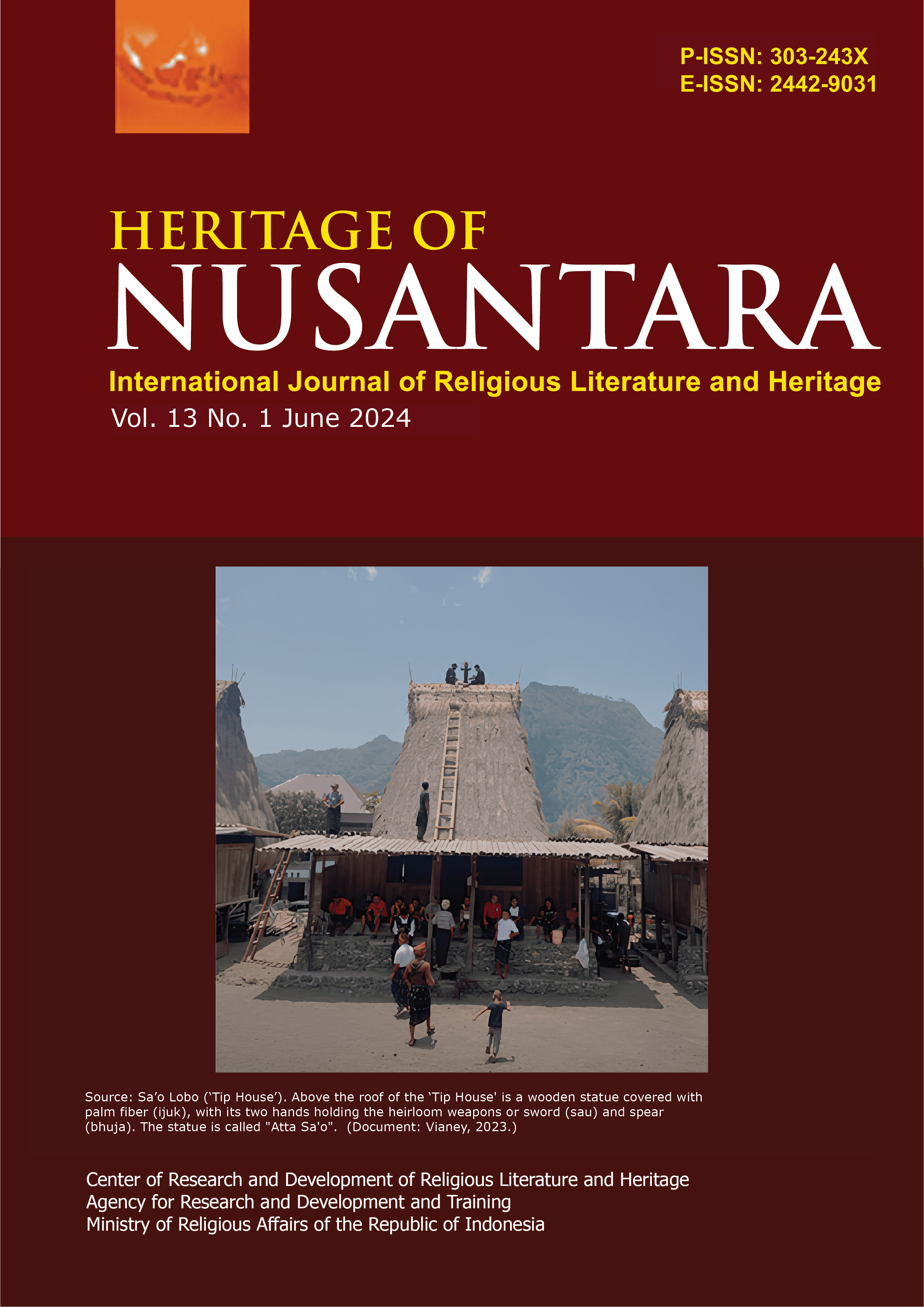Miasma as Earthquake Impact Depicted in Ambon Manuscript: A Disaster Semiotic Perspective
DOI:
https://doi.org/10.31291/hn.v13i1.737Keywords:
manuscript, earthquake, miasma, disaster, semiotic, AmbonAbstract
This study aims to explore the concept of miasma and the spiritual implications of earthquakes as depicted in the Naskah Cerita Gempa (The Story of Earthquake) manuscript found in Ambon, “The Story of Earthquake” is a manuscript from the collection of Husain Hatuwe. It is cataloged in both the Ambon Manuscript Catalog and the Religious Catalog of the Makassar Research and Development Center, under the Ministry of Religious Affairs of the Republic of Indonesia. The manuscript has been digitized through a collaborative effort between the Pernaskahan Nusantara Foundation and the Faculty of Cultural Sciences at the University of Indonesia, in partnership with the Endangered Archives Programme (EAP) of the British Library. The digitized version of “The Story of Earthquake” manuscript can be accessed online via the EAP British Library’s website using the code EAP276/7/10. This study employs a textual analysis adopting Han-Liang Chang’s disaster semiotics methodology which categorizes disasters into three phases: natural events, interpretations and effects. The findings of this study reveal that natural events, in the form of weather changes associated with miasma, have a significant impact on all forms of life, including animals, plants and humans. These changes lead to damage and death, prompting individuals to seek protection. This research underscores the profound spiritual and physical effects of natural disasters as interpreted through the lens of the Naskah Cerita Gempa manuscript.
Downloads
References
Achadiati, Kramadibrata, D., Pudjiastuti, T., Buduroh, M., & Holil, M. (2011). Katalog Naskah Ambon. Depok: Yayasan Naskah Nusantara dan British Library.
Akhimuddin, Y. (2013). Naskah-naskah Gempa: Perspektif Orang Melayu Minangkabau tentang Gempa Bumi. Jakarta: LeKAS Publishing.
Al-Khatib, M. A. (1995). Makna Hijrah Dulu dan Sekarang. Malang: Gema Insani Press.
Arfiansyah, Dewi, C., Srimulyani, E., Rauzi, E. N., Fakhriati, Mundir, I., Fahlevi, R., & Mahdi, S. (2019). Peran Kementrian Agama dalam Mitigasi Bencana di Aceh. Journal of Chemical Information and Modeling (Vol. 53, Issue 9).
Assagaf, H. (2018). Posisi Islam dalam Sejarah Pemerintahan Negeri Adat di Pulau Ambon. Dialektika, 9(2), 19–33.
Chambert-Loir, H., & Kramadibrata, D. (2014). Katalog Naskah Pecenongan Koleksi Perpustakaan Nasional. Jakarta: Perpustakaan Nasional Republik Indonesia.
Chang, H.-L. (2005). Disaster Semiotics: An Alternative “Global Semiotics”? International Semiotics Institute, March, 25–27.
Fathurahman, O. (2015). Filologi Indonesia Teori dan Metode. Jakarta: Kencana Prenamedia Group
Firdaus. (2017). The Contribution of Scholars in Addressing Earthquake and Tsunami (The Study of Malay Minangkabau Manuscripts). INSANIYAT: Journal of Islam and Humanities, 2(1), 29–40. http://journal.uinjkt.ac.id/index.php/insaniyat/article/view/ 6587/4014
Hamzah, L., Puspito, N. T., & Imamura, F. (2000). Tsunami Catalog and zones in Indonesia. Journal of Natural Disaster Science, 22(1), 25–43. /https://doi.org/10.2328/jnds.22.25
Hermansyah. (2012). Naskah Ta’bir Gempa; Antara Mitigasi Bencana dan Kearifan Lokal di Aceh (Kajian Terhadap Naskah-naskah Kuno). Proceeding ADIC III, 3, 1–16. http://oreilly.com/ catalog/errata.csp?isbn=9781449340377
Hoed, B. H. (2014). Semiotik dan Dinamika Sosial Budaya (3rd ed.). Depok: Komunitas Bambu.
Jaelani, A. G. (2019). Naturalis, dokter, dan ahli ilmu bumi: Penyelidikan gempa dan gunung meletus di Hindia-Belanda pada abad ke-19. Jurnal Sejarah, 2(2), 32–49. https://doi.org/10. 26639/js.v2i2.232
Katili, J. A. (1989). Review of past and present geotectonic concepts of eastern indonesia. Netherlands Journal of Sea Research, 24(2–3), 103–129. https://doi.org/10.1016/0077-7579(89)90143-9
Kramadibrata, D. (2019). Hikayat Khalifah Abu Bakar, Umar, Usman, dan Ali Sampai Peperangan Hasan dan Husain di Karbala: Kisah Muhammad Hanafiyah dari Ambon. Jakarta: Perpustakaan Nasional Republik Indonesia.
Last, J. M. (2007). A Dictionary of Public Health. Oxford: Oxford University Press.
Mulyoutami, E., Noordwijk, M. van, Sakuntaladewi, N., & Agus, F. (2010). Perubahan Pola Perladangan: Perubahan Persepsi Mengenai Para Peladang di Indonesia. World Agroforestry Centre - ICRAF.
Noor, D. (2014). Pengantar Geologi. Sleman: Deepublish.
Pirol, A., & Aswan. (2018). Semiotika Bencana dan Petunjuk Keselamatan Masyarakat: Studi Semiotika Komunikasi terhadap Makna Tanda-tanda Alam dalam Pengetahuan Lokal Masyarakat Luwu. SOSIO DIDAKTIKA: Social Science Education Journal, 5(2), 61-70. https://doi.org/10.15408/sd.v5i2.9891
Pramono, Putra, A., Chairullah, R. B., Hidayat, A. T., Sandora, L., Chaniago, M. D., Sudarman, & Hendrajaya, J. (2019). Peran Kementerian Agama dalam Mitigasi Bencana Alam di Sumatera Barat. Jakarta: Puslitbang Lektur, Khazanah Keagamaan, dan Manajemen Organisasi.
Robson, S. O. (1978). Pengkajian Sastra-sastra Tradisional Indonesia dalam Bahasa dan Sastra Tahun IV No. 6. Jakarta: Pusat Pembinaan dan Pengembangan Bahasa, Departeman Pendidikan dan Kebudayaan.
Robson, S. O. (1994). Teori, Metode, dan Teknik Penelitian Sastra. Jakarta: Perpustakaan Nasional Republik Indonesia.
Satake, K. (2015). Geological and historical evidence of irregular recurrent earthquakes in Japan. Philosophical Transactions of the Royal Society A: Mathematical, Physical and Engineering Sciences, 373(2053). https://doi.org/10.1098/rsta.2014.0375
Schwartz, D. P., & Coppersmith, K. J. (2012). Fault behavior and characteristic earthquakes: Examples from the Wasatch and San Andreas Fault Zones. Journal of Geophysical Research. https://doi.org/10.1029/JB089iB07p05681
Setyawati, S., Pramono, H., & Ashari, A. (2015). Kecerdasan Tradisional dalam Mitigasi bencana Erupsi pada Masyarakat Lereng Baratdaya Gunungapi Merapi. SOCIA: Jurnal Ilmu-Ilmu Sosial, 12(2), 100–110. https://doi.org/10.21831/socia.v12i2.12240
Sudibyo, S. (2019). Letusan Gunung dan Persepsi Sang Pujangga: Kesaksian Teks Bima, Jawa, dan Melayu Abad ke-19. Manuskripta, 9(1). https://doi.org/10.33656/ manuskripta.v9i1.133
Sunarto. (2011). Pemaknaan Filsafati Kearifan Lokal untuk Adaptasi Masyarakat Terhadap Ancaman Bencana Marin dan Fluvial di Lingkungan Kepesisiran. Forum Geografi, 25(1), 1–16.
Suyami, Taryati, & Sumarno. (2015). Kajian Kebencanaan dalam Naskah Panjeblugipun Redi Kelut. Yogyakarta: Balai Pelestarian Nilai Budaya Daerah Istimewa Yogyakarta.
Trabaut, J. (1996). Dasar-dasar Semiotik (Elemente der Semiotik) (Terjemahan). Jakarta: Pusat Pembinaan dan Pengembangan Bahasa, Departeman Pendidikan dan Kebudayaan.
Ulumi, H. N. B., Fahrudin, A., Firmanto, A., Sobariah, L., Ahyadi, Y., Romi, & Muzhiat, A. (2019). Peran Kementerian Agama dalam Mitigasi Bencana Alam di Banten. Jakarta: Puslitbang Lektur, Khazanah Keagamaan, dan Manajemen Organisasi.
Downloads
Published
Issue
Section
License
Copyright (c) 2024 Heritage of Nusantara: International Journal of Religious Literature and Heritage

This work is licensed under a Creative Commons Attribution-NonCommercial-ShareAlike 4.0 International License.






